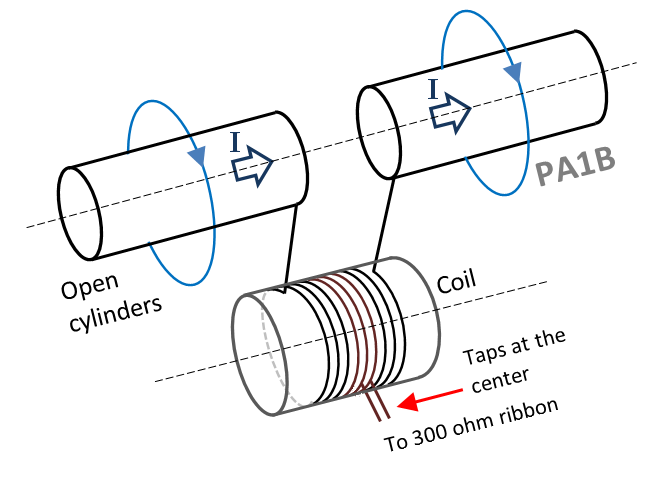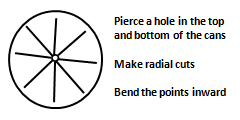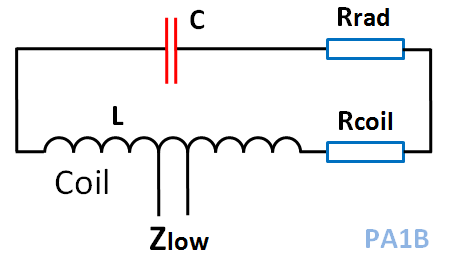The cylinder dipole by Bert PA1B
The cylinder dipole has proven to be a very small indoor HF-antenna. The cylinder dipole with two Monster energy drink cans and a coil is easy to build and is working fine on 15 m.
From measurements I have calculated, that the efficiency of this cylinder dipole is 75%, which is very good. The efficiency is very good, for a very short antenna, with a wingspan of just 2.5% of the wavelength.
I have a lot of fun in QRP CW contest QSO’s with this cylinder dipole in the shack at the first floor, just 4 meter above the ground. With this indoor cylinder dipole I worked many DXCC’s all over Europe.

The cylinder dipole consists of two conductive cylinder and a coil.
Construction
To keep it simple, I built a cylinder dipole for 21 MHz with two Monster energy drink cans of 500 ml and a coil. The cans are very good available, although I don’t drink the energy drink my self. The cans are made of aluminium and are easy to treat with a tin shear and an awl.
With an awl I pierced a hole in the bottom of the drink cans. Then I made radial cuts with a tin shear in the bottom of the cans and folded the points inwards. Please be careful for your hands. I made cuts from the drink hole in the top of the cans. I don’t remove the rims, so the cans keep their strength.
I connected the wires to the cans with a screw and a bolt to get a good connection with a low resistance.
Then I put a white PP tube of 40 mm through the cans to support the cans. The cans can be shifted along the tube at all times.

The coil has 9 turns on a coil former of of grey PVC with a diameter of 80 mm. I used a flexible wire of 1.5 square millimeter. The coil is connected to the wires of the cylinders via a wire connector. The coil is hanging below the cylinders. The cylinder dipole is fed via a 300 ohm twin lead, that is connected to two taps at the center of the coil. The taps are ONE turn apart.
Efficiency
This cylinder dipole has a good efficiency by the use of a parallel tuned circuit. The cans act as radiators. The radiation is caused by the current, that is flowing on the surface of the cans.
The length of the dipole determines the radiation resistance of the dipole. The radiation resistance is very low, because of the short length of the dipole.
The resistance of the coil is in series with the radiation resistance of the dipole. But the resistance of the coil is lower than the radiation resistance.
In measurements of the cylinder dipole I determined that this cylinder dipole has a efficiency of 75%, which is very good. So the cylinder dipole is very short, but has a good efficiency. It is the parallel tuned circuit, that gives the cylinder dipole it’s good efficiency.
Parallel resonance
The cylinders show a large capacity. This capacity between the cylinders is 6 pF. This capacity is much larger, than the capacity of two wires with the same length as the cans. The capacity of the cylinders and the induction of the coil form a parallel LC resonant circuit on 21 MHz. The parallel LC circuit shows a high impedance at resonance. The cylinder dipole is tuned by choosing the number of turns of the coil. The coil can be fine tuned, by changing the spacing between the turns.
The cylinder dipole can be easily tuned by changing the space between the two cylinders. The cylinders can be shifted along the white PP tube at all times.

Feed point
I made taps, at the center of the coil. The connection on the taps of the coil, form a feed point with low impedance, to which the 300 ohm twin lead is connected. The lower the number of turns between the taps, the lower the impedance will be. The impedance on the feed point will NOT be 300 ohms.
I had good results with the taps just ONE turn apart. Please notice, that the taps are placed at center the coil. Because of the symmetry, the twin lead will not show hand effect.

The PA1B cylinder dipole
Matching
The cylinder dipole is matched (not tuned) by the symmetrical tuner in the shack. The tuner is adjusted to a SWR of 1:1
That’s all.
If you can not get a SWR of 1:1, just try a twin lead with an other length. A twin lead with a certain length will also act as an impedance transformer.
Multiband
The cylinder dipole with Monster cans has a good efficiency on 21 MHz. But I discovered that it can also be used, as a multi band antenna, simply by matching the antenna to a SWR of 1:1 on the band that you want to use, such as 24 MHz or 28 MHz. On 14 MHz the radiation resistance will be lower, so the efficiency will be not as good as on 21 MHz. But with good propagation you will also make QSO’s on 14 MHz.
Results
I had great fun with the cylinder dipole in QSO’s with many DXCC’s. I have made more than hundred contest QSO’s in CW, from the shack, all over Europe.
The cylinder dipole with the Monster cans works great on 15 m.
I made QSO’s with 3 watts and also QRPp, which is less than 1 watt.
The best DX to the east is with R0AA in Achinsk over 5200 km. The best DX to the west is with N1KWF in New Hampshire over a distance of 5300 km. Both these QSO’s were made with 3 watts.
I made many “more than 1000 Miles per Watt” QSO’s with QRPp (less than 1 watt). The lowest power that I used was 72 mW. Hi.
Try it your self
The cylinder dipole is very small antenna, that can be easily used indoors. It will fit in your shack or an other part of the house. Building and operating with the cylinder dipole is not as difficult as it seams. There are no critical parts or critical procedures.
I found out that the cylinder dipole will even work, when it is not perfectly tuned, to the band on which you want to operate. Hi.
With this cylinder dipole it is possible to work all over Europe with QRP or QRPp. Just look for a loud signal on 21 MHz and try your luck by answering the CQ.
I wish you good luck, but most of all to have fun.
